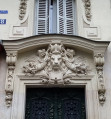Refine your search for walks in Butte Bergeyre
Butte Bergeyre walks
 In the heights of Paris: Buttes Chaumont, Butte Bergeyre, Belleville
In the heights of Paris: Buttes Chaumont, Butte Bergeyre, Belleville

The third stage of this urban journey crosses the north-eastern districts of Paris, including the lively Belleville neighbourhood. We wind our way through the Parc des Buttes Chaumont and then climb the discreet Butte Bergeyre, which offers an original view of Montmartre. We then pass by the Rue Piat viewpoint, which offers a panoramic view. A few touches of urban heritage and street art, as well as a walk along the Canal Saint-Martin, complete the picture.
Walks near Butte Bergeyre
 In the footsteps of Georges Brassens: La Goutte d'Or, Montmartre and Trinité
In the footsteps of Georges Brassens: La Goutte d'Or, Montmartre and Trinité

This second section takes us to the old cabaret (Chez Patachou) where Georges Brassens performed in public for the first time. The walk through Montmartre, with its slopes, paths and stairways, is particularly pleasant (best done in the "low tourist season").
 Walk in the Marais
Walk in the Marais

This is an immersion in a historic district of Paris that was largely untouched by Haussmann's urban renewal and has retained many narrow streets, with architecture still dominated by 17th-century mansions. The suggested itinerary winds its way through narrow streets and gardens, allowing you to discover a rich heritage, including the Carreau du Temple, the Hôtel du Grand Veneur, the gardens of the National Archives, the Place des Vosges and the Hôtel Sully.
 The Petite Ceinture in the 20th arrondissement, La Mouzaïa and the Bassin de la Villette
The Petite Ceinture in the 20th arrondissement, La Mouzaïa and the Bassin de la Villette

A stroll through the 20th and 19th arrondissements of Paris, taking in their diverse neighbourhoods. We cross Ménilmontant, roughly following the old Petite Ceinture railway line, then take a look at the old Belleville aqueduct. The neighbourhood around Rue de la Mouzaïa reveals its sloping streets lined with small houses decorated with flowers. We finish at the edge of the Bassin de la Villette and the Canal Saint-Denis.
 In the footsteps of Georges Brassens: Belleville and Canal Saint-Martin
In the footsteps of Georges Brassens: Belleville and Canal Saint-Martin

In this first section of our "Brassens" walk, we first pass through the Belleville and Ménilmontant neighbourhoods, with their narrow streets, footpaths and stairways. Then, after crossing the symbol-rich Place de la République, we walk along the charming Canal Saint-Martin.
 The Village Saint-Paul, Île Saint-Louis and Île de la Cité
The Village Saint-Paul, Île Saint-Louis and Île de la Cité

The last stage of this journey takes us to the historic heart of Paris, where we discover a rich heritage. The labyrinthine streets of the Village Saint-Paul are followed by the Île Saint-Louis and its 17th-century mansions. The Île de la Cité is a delight in itself, with Notre-Dame as its highlight. And the Seine is always in the background...
The route and description take into account areas closed to the public following the Notre Dame fire in April 2019.
 On the French Revolution routes in the heart of Paris
On the French Revolution routes in the heart of Paris

An urban circular walk in search of the French Revolution routes in two Parisian sites: the Bastille, whose capture had a very strong symbolic impact, and the Odéon suburb, where several key figures of the period lived, worked and gathered, including Marat and Danton. It's also an opportunity to discover the signs of other insurrectionary episodes (July 1830, May 1968) and a superb heritage ranging from the Gallo-Roman to the Middle Ages period.
 The René Dumont greenway
The René Dumont greenway

The René Dumont greenway is built on the platform of the former railway line that ran from the Gare de la Bastille. After briefly following the Canal Saint-Martin before it flows into the Seine, you follow this green space through the city, first at a height and then at ground level or through short tunnels. The Jardin de Reuilly, Square Charles Péguy and the Friche Ferroviaire at the junction of the former Petite Ceinture line add to the charm of this route.
 From Châtelet to Austerlitz
From Châtelet to Austerlitz

A walk between Châtelet and Austerlitz, along picturesque streets rich in Parisian history with many points of interest: gardens, monuments, building facades, etc. Depending on your pace and curiosity, the route can take between two and four hours.
 The Philippe Auguste enclosure and the covered passages of the Sentier
The Philippe Auguste enclosure and the covered passages of the Sentier

This route on the right bank of the Seine takes us on a journey from medieval times to Art Nouveau. First, we discover the most important remains of Philippe Auguste's city walls and former mansions. We then wind our way through the Sentier district to explore several of its covered passages.
This walk is best done during the week, as the covered passages are closed on certain days.
 From the Louvre to the Bastille via the Tour Saint-Jacques
From the Louvre to the Bastille via the Tour Saint-Jacques

An urban route steeped in history, where 16th- and 17th-century buildings stand alongside modern architecture. This is how you will go from the Palais Royal to the Forum des Halles, from the Church of Saint-Eustache to the Centre Beaubourg, and from the Tour Saint-Jacques to the Opéra Bastille. The itinerary winds its way through streets, alleys, passageways and gardens, offering visitors the chance to discover a rich and diverse heritage.

